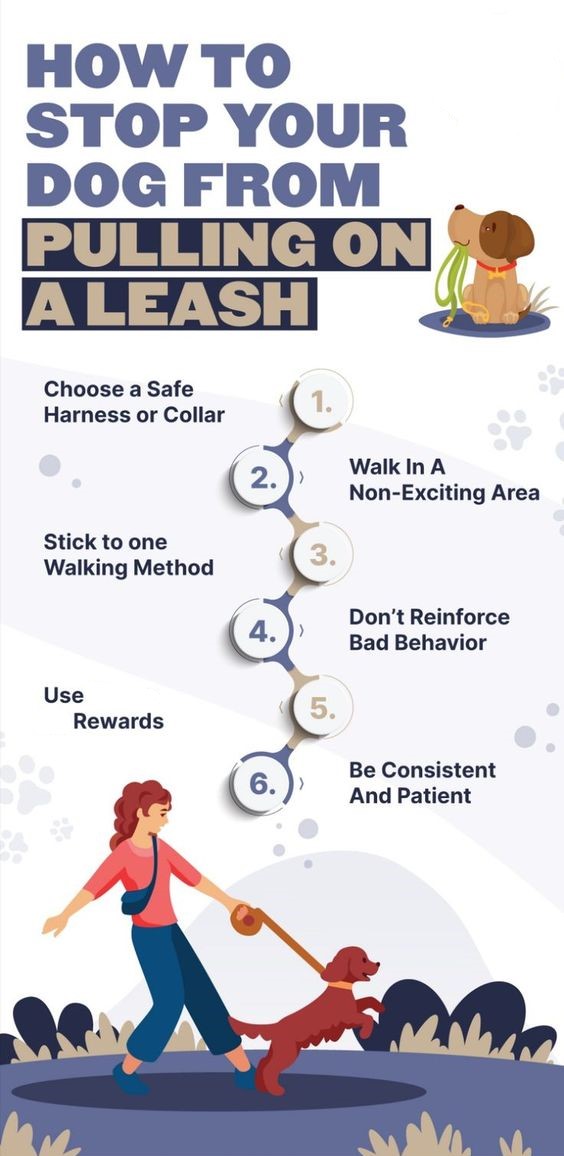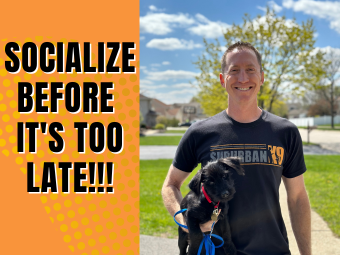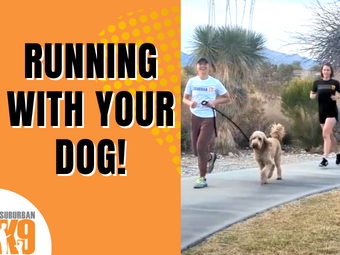We know ever since you got a dog, you can't wait to take it out for a long walk to watch the sunset together. But his scenic journey can turn into a wild zigzag if you've skipped leash training. It is an essential part of owning one and no matter how long it takes to leash train a dog, there is no escaping it.
Leash training is about changing your dog's perspective. From their point of view, that leash is the ultimate tug-of-war toy. So your task is to flip that script and teach them that walking calmly by your side is the new cool – not as easy as it sounds.
Then we have the issue of attention span. When they are more interested in every scent, leaf, blade of grass, and passing squirrel, focusing on walking in a straight line becomes secondary.
If you don't want to be that person who is frantically pulled down the street by your dog, we just made your day. Our article is a complete guide and your leash training survival kit. From covering the basics to reaching the bottom of this, you will find everything here.
Understanding The A-Zs Of Leash Training
Since the day the puppy stepped into your world, you have been on a loop teaching it the ins and outs of living an urban life. This can include crating, housebreaking, basic obedience, and socializing. You may have not noticed but there is something very crucial missing from this list. It’s called walking on a leash aka leash training.
Leash training is like a crash course for your dog to learn sidewalk manners. The main purpose of this training is for the dog to understand that when outdoors, following your lead is the ultimate thing to do. It keeps them safe and promotes a positive walking experience for both the dog and the owner.
You may think how complicated leash training can be?. Just buckle the leash with the collar and off you go. Well, to be honest, it’s not complicated at all. Only the surrounding competition can make it fierce. Since it's you against the interesting outdoor world that includes squirrels, kids, buzzing cars, and yes more squirrels, these stimuli will urge them to yank or pull the leash towards these profound distractions.
This is where loose leash training steps in.
What Is Loose Leash Training?
As the name suggests, a loose leash is when your dog is walking by your side and the leash does not have a pull to it. It can only happen if the dog is trained to walk close to its owner's side – not ahead and not behind. We agree that teaching your dog to walk calmly on a leash is an investment of time and effort but it yields a lifetime of relaxed outdoor time with your furry friend.
Loose leash walking has lots of benefits. While out on dog walks, the aim is to keep everything calm and under control. No chaos, no havoc. Also, to teach the dog that it is you who makes the decisions.
As you go through this process, your dog becomes a master of self-discipline. They learn to resist the urge to pounce on that leftover pizza crust on the sidewalk or to resist chasing after every fluttering leaf in the wind. It's all thanks to the groundwork you've laid in their training.
Loose leash training your dog gives you social ease. You can actually engage in a conversation with your neighbor that doesn't involve contorted arm positions and strained "I'm-trying-to-control-my-dog" smiles. It can also help steer clear of trips and fall injuries for you and the people around you.
Here's a neat advantage: loose leash walking also provides a mental workout for your dog as they learn how to navigate the world around them. All those sights, sounds, and smells are like a puzzle, and they're on a mission to figure it all out while staying calm and composed.
The Ideal Time To Start Leash Training Your Dog
If you have an older dog (that you adopted from a rescue home or for whatever reason) that has never been leash trained before, the ideal time to start leash training is now. For puppies, we suggest starting loose-leash training as soon as they are brought home.
Puppies have a natural tendency to follow their owners around which helps in lease training. Additionally, they are more receptive to learning and adaptive to new experiences. The earlier they become accustomed to the sensation of wearing a collar and a leash, the stronger the foundation for leash training will be. Knowing these insights, it is much easier to leash-train them before they reach adolescence.
Also, we can't ignore the fact that puppies need to be socialized as soon as possible since their socialization window is very small. It's during this period that they learn what's normal, what's exciting, and what's just part of everyday life. But if they are not fully leash trained, the socialization experience could quickly turn into a wild chase scene from an action movie.
Just a word of caution here: older dogs have already developed their core habits and are rigid towards absorbing new ones. It is going to take more effort, patience, and consistency from your side to train loose-leash walking without playing tug-of-war.
Expert Advice:
Even if you have already fully leash-trained your puppy, a little reinforcement now and then comes in very handy. Dogs tend to forget what they have learned earlier, especially when they reach adolescence.
How Long Does It Take To Leash Train A Dog?
On average, a 3 to 4-week period is enough to leash train a dog. That said, it varies for every dog. Your dog’s age will be the major deciding factor here. A puppy’s brain is like a sponge, absorbing everything they see quickly. So it is natural that they start picking up the basics of leash training more swiftly.
If you are leash training an older dog, the timeline might stretch beyond those initial weeks. May take a few months also. The reason here is these seasoned pups have already gotten used to their own way of doing things. They have established their walking pattern fine-tuned over the years. You know what they say, old habits die hard. Trying to break free from those habits can be a bit like teaching an old dog a new trick, quite literally.
So it is going to take some tactical training for older guys that need more precision, persistence, and patience. On the plus side, since older dogs are well-versed in basic obedience commands, it makes it easy to communicate with them.
Remember, it's not just about the age, but also the temperament, breed, and past experiences of your dog. If your pup had a not-so-pleasant run-in with a vacuum cleaner, they might approach the leash with caution. On the other hand, if they've been the social butterfly at the dog park, they will take leash training like a champ.
Other factors include the location where you are training your dog, the weather (believe it or not), and most importantly, the training strategies used.
If you're using leash training methods that have some gaps in them, you might find yourself on a bit of a detour before reaching your training goals. But we will make life easier for you. We compiled the 5 best leash training strategies that will give you sure-shot results. Hop on to the next section for the full blowout.
5 No-Fail Leash Training Steps For Enjoyable Dog Walking
All you need to do is to set aside 5 to 10 minutes of your time every day and follow our foolproof strategy for leash training your dog. Good things are coming your way.
1. Gather The Right Tools
This is important for laying the right foundation. If you have the right tools by your side, achieving the goal is much easier. Get yourself a collar that fits just right – not too roomy and not too snug. Once you have the collar on your furry buddy, give a gentle tug to see if it slips over their head. If it does, remember your smart pup can likely do the same trick.
- REAL GENUINE LEATHER dog training leash is real Italian imported leather.
- METAL CLIPS Using pure copper alloy casting.
- Law enforcement and military grade of professional training.
- CONVENIENT AND COMFORTABLE length for training.
- New design short dog leash padded handle
- 100% genuine leather sew by hand
- Width: 2/5 inches Length: 9 inches Weight: 150g
- Adjustable between the rustproof hook and the lead
- Very comfortable soft leash handle for dog show, patrolling, walking
We know ever since you got a dog, you can't wait to take it out for a long walk to watch the sunset together. But his scenic journey can turn into a wild zigzag if you've skipped leash training. It is an essential part of owning one and no matter how long it takes to leash train a dog, there is no escaping it.
Leash training is about changing your dog's perspective. From their point of view, that leash is the ultimate tug-of-war toy. So your task is to flip that script and teach them that walking calmly by your side is the new cool – not as easy as it sounds.
Then we have the issue of attention span. When they are more interested in every scent, leaf, blade of grass, and passing squirrel, focusing on walking in a straight line becomes secondary.
If you don't want to be that person who is frantically pulled down the street by your dog, we just made your day. Our article is a complete guide and your leash training survival kit. From covering the basics to reaching the bottom of this, you will find everything here.
Understanding The A-Zs Of Leash Training
Since the day the puppy stepped into your world, you have been on a loop teaching it the ins and outs of living an urban life. This can include crating, housebreaking, basic obedience, and socializing. You may have not noticed but there is something very crucial missing from this list. It’s called walking on a leash aka leash training.
Leash training is like a crash course for your dog to learn sidewalk manners. The main purpose of this training is for the dog to understand that when outdoors, following your lead is the ultimate thing to do. It keeps them safe and promotes a positive walking experience for both the dog and the owner.
You may think how complicated leash training can be?. Just buckle the leash with the collar and off you go. Well, to be honest, it’s not complicated at all. Only the surrounding competition can make it fierce. Since it's you against the interesting outdoor world that includes squirrels, kids, buzzing cars, and yes more squirrels, these stimuli will urge them to yank or pull the leash towards these profound distractions.
This is where loose leash training steps in.
What Is Loose Leash Training?
As the name suggests, a loose leash is when your dog is walking by your side and the leash does not have a pull to it. It can only happen if the dog is trained to walk close to its owner's side – not ahead and not behind. We agree that teaching your dog to walk calmly on a leash is an investment of time and effort but it yields a lifetime of relaxed outdoor time with your furry friend.
Loose leash walking has lots of benefits. While out on dog walks, the aim is to keep everything calm and under control. No chaos, no havoc. Also, to teach the dog that it is you who makes the decisions.
As you go through this process, your dog becomes a master of self-discipline. They learn to resist the urge to pounce on that leftover pizza crust on the sidewalk or to resist chasing after every fluttering leaf in the wind. It's all thanks to the groundwork you've laid in their training.
Loose leash training your dog gives you social ease. You can actually engage in a conversation with your neighbor that doesn't involve contorted arm positions and strained "I'm-trying-to-control-my-dog" smiles. It can also help steer clear of trips and fall injuries for you and the people around you.
Here's a neat advantage: loose leash walking also provides a mental workout for your dog as they learn how to navigate the world around them. All those sights, sounds, and smells are like a puzzle, and they're on a mission to figure it all out while staying calm and composed.
The Ideal Time To Start Leash Training Your Dog
If you have an older dog (that you adopted from a rescue home or for whatever reason) that has never been leash trained before, the ideal time to start leash training is now. For puppies, we suggest starting loose-leash training as soon as they are brought home.
Puppies have a natural tendency to follow their owners around which helps in lease training. Additionally, they are more receptive to learning and adaptive to new experiences. The earlier they become accustomed to the sensation of wearing a collar and a leash, the stronger the foundation for leash training will be. Knowing these insights, it is much easier to leash-train them before they reach adolescence.
Also, we can't ignore the fact that puppies need to be socialized as soon as possible since their socialization window is very small. It's during this period that they learn what's normal, what's exciting, and what's just part of everyday life. But if they are not fully leash trained, the socialization experience could quickly turn into a wild chase scene from an action movie.
Just a word of caution here: older dogs have already developed their core habits and are rigid towards absorbing new ones. It is going to take more effort, patience, and consistency from your side to train loose-leash walking without playing tug-of-war.
Expert Advice:
Even if you have already fully leash-trained your puppy, a little reinforcement now and then comes in very handy. Dogs tend to forget what they have learned earlier, especially when they reach adolescence.
How Long Does It Take To Leash Train A Dog?
On average, a 3 to 4-week period is enough to leash train a dog. That said, it varies for every dog. Your dog’s age will be the major deciding factor here. A puppy’s brain is like a sponge, absorbing everything they see quickly. So it is natural that they start picking up the basics of leash training more swiftly.
If you are leash training an older dog, the timeline might stretch beyond those initial weeks. May take a few months also. The reason here is these seasoned pups have already gotten used to their own way of doing things. They have established their walking pattern fine-tuned over the years. You know what they say, old habits die hard. Trying to break free from those habits can be a bit like teaching an old dog a new trick, quite literally.
So it is going to take some tactical training for older guys that need more precision, persistence, and patience. On the plus side, since older dogs are well-versed in basic obedience commands, it makes it easy to communicate with them.
Remember, it's not just about the age, but also the temperament, breed, and past experiences of your dog. If your pup had a not-so-pleasant run-in with a vacuum cleaner, they might approach the leash with caution. On the other hand, if they've been the social butterfly at the dog park, they will take leash training like a champ.
Other factors include the location where you are training your dog, the weather (believe it or not), and most importantly, the training strategies used.
If you're using leash training methods that have some gaps in them, you might find yourself on a bit of a detour before reaching your training goals. But we will make life easier for you. We compiled the 5 best leash training strategies that will give you sure-shot results. Hop on to the next section for the full blowout.
5 No-Fail Leash Training Steps For Enjoyable Dog Walking
All you need to do is to set aside 5 to 10 minutes of your time every day and follow our foolproof strategy for leash training your dog. Good things are coming your way.
1. Gather The Right Tools
This is important for laying the right foundation. If you have the right tools by your side, achieving the goal is much easier. Get yourself a collar that fits just right – not too roomy and not too snug. Once you have the collar on your furry buddy, give a gentle tug to see if it slips over their head. If it does, remember your smart pup can likely do the same trick.







